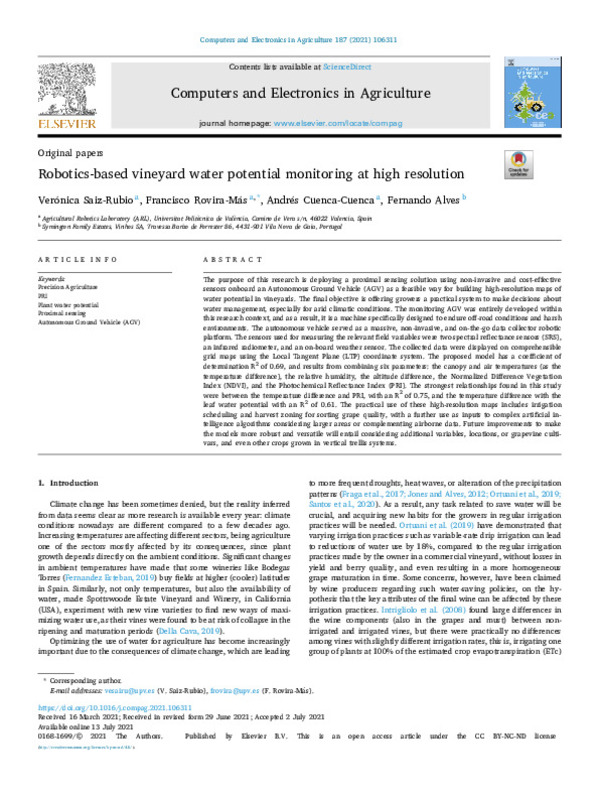JavaScript is disabled for your browser. Some features of this site may not work without it.
Buscar en RiuNet
Listar
Mi cuenta
Estadísticas
Ayuda RiuNet
Admin. UPV
Robotics-based vineyard water potential monitoring at high resolution
Mostrar el registro sencillo del ítem
Ficheros en el ítem
| dc.contributor.author | Saiz-Rubio, Verónica
|
es_ES |
| dc.contributor.author | Rovira Más, Francisco
|
es_ES |
| dc.contributor.author | Cuenca-Cuenca, Andrés
|
es_ES |
| dc.contributor.author | Alves, Fernando
|
es_ES |
| dc.date.accessioned | 2023-09-18T18:01:59Z | |
| dc.date.available | 2023-09-18T18:01:59Z | |
| dc.date.issued | 2021-08 | es_ES |
| dc.identifier.issn | 0168-1699 | es_ES |
| dc.identifier.uri | http://hdl.handle.net/10251/196714 | |
| dc.description.abstract | [EN] The purpose of this research is deploying a proximal sensing solution using non-invasive and cost-effective sensors onboard an Autonomous Ground Vehicle (AGV) as a feasible way for building high-resolution maps of water potential in vineyards. The final objective is offering growers a practical system to make decisions about water management, especially for arid climatic conditions. The monitoring AGV was entirely developed within this research context, and as a result, it is a machine specifically designed to endure off-road conditions and harsh environments. The autonomous vehicle served as a massive, non-invasive, and on-the-go data collector robotic platform. The sensors used for measuring the relevant field variables were two spectral reflectance sensors (SRS), an infrared radiometer, and an on-board weather sensor. The collected data were displayed on comprehensible grid maps using the Local Tangent Plane (LTP) coordinate system. The proposed model has a coefficient of determination R-2 of 0.69, and results from combining six parameters: the canopy and air temperatures (as the temperature difference), the relative humidity, the altitude difference, the Normalized Difference Vegetation Index (NDVI), and the Photochemical Reflectance Index (PRI). The strongest relationships found in this study were between the temperature difference and PRI, with an R-2 of 0.75, and the temperature difference with the leaf water potential with an R-2 of 0.61. The practical use of these high-resolution maps includes irrigation scheduling and harvest zoning for sorting grape quality, with a further use as inputs to complex artificial intelligence algorithms considering larger areas or complementing airborne data. Future improvements to make the models more robust and versatile will entail considering additional variables, locations, or grapevine cultivars, and even other crops grown in vertical trellis systems. | es_ES |
| dc.description.sponsorship | This work has been developed under grant agreement N¿737669 of the European Union¿s Horizon 2020 research and innovation program, and it has received the support of Symington Family States owners and technicians, whose assistance is deeply appreciated. In particular, the Symington family (Dominic, John, and Charles), and staff members Joana Valente, Artur Moreira, and Pedro Leal da Costa. Likewise, Juan José Peña Suárez and Montano Pérez Teruel from the Universitat Politècnica de València in Spain are greatly thanked for their continuous support. This work was supported by the European Union's Horizon 2020 research and innovation programme (grant agreement number 737669) . The opinions expressed reflect only the authors' view. Neither the European Commission, nor the funding agency, nor its services are responsible for any use that may be made of the information that this publication contains. | es_ES |
| dc.language | Inglés | es_ES |
| dc.publisher | Elsevier | es_ES |
| dc.relation.ispartof | Computers and Electronics in Agriculture | es_ES |
| dc.rights | Reconocimiento - No comercial - Sin obra derivada (by-nc-nd) | es_ES |
| dc.subject | Precision Agriculture | es_ES |
| dc.subject | PRI | es_ES |
| dc.subject | Plant water potential | es_ES |
| dc.subject | Proximal sensing | es_ES |
| dc.subject | Autonomous Ground Vehicle (AGV) | es_ES |
| dc.subject.classification | INGENIERIA AGROFORESTAL | es_ES |
| dc.title | Robotics-based vineyard water potential monitoring at high resolution | es_ES |
| dc.type | Artículo | es_ES |
| dc.identifier.doi | 10.1016/j.compag.2021.106311 | es_ES |
| dc.relation.projectID | info:eu-repo/grantAgreement/EC/H2020/737669/EU | es_ES |
| dc.rights.accessRights | Abierto | es_ES |
| dc.contributor.affiliation | Universitat Politècnica de València. Escuela Técnica Superior de Ingeniería Agronómica y del Medio Natural - Escola Tècnica Superior d'Enginyeria Agronòmica i del Medi Natural | es_ES |
| dc.description.bibliographicCitation | Saiz-Rubio, V.; Rovira Más, F.; Cuenca-Cuenca, A.; Alves, F. (2021). Robotics-based vineyard water potential monitoring at high resolution. Computers and Electronics in Agriculture. 187:1-12. https://doi.org/10.1016/j.compag.2021.106311 | es_ES |
| dc.description.accrualMethod | S | es_ES |
| dc.relation.publisherversion | https://doi.org/10.1016/j.compag.2021.106311 | es_ES |
| dc.description.upvformatpinicio | 1 | es_ES |
| dc.description.upvformatpfin | 12 | es_ES |
| dc.type.version | info:eu-repo/semantics/publishedVersion | es_ES |
| dc.description.volume | 187 | es_ES |
| dc.relation.pasarela | S\442498 | es_ES |
| dc.contributor.funder | COMISION DE LAS COMUNIDADES EUROPEA | es_ES |
| dc.subject.ods | 02.- Poner fin al hambre, conseguir la seguridad alimentaria y una mejor nutrición, y promover la agricultura sostenible | es_ES |
| dc.subject.ods | 12.- Garantizar las pautas de consumo y de producción sostenibles | es_ES |
| dc.subject.ods | 13.- Tomar medidas urgentes para combatir el cambio climático y sus efectos | es_ES |
| dc.subject.ods | 15.- Proteger, restaurar y promover la utilización sostenible de los ecosistemas terrestres, gestionar de manera sostenible los bosques, combatir la desertificación y detener y revertir la degradación de la tierra, y frenar la pérdida de diversidad biológica | es_ES |








